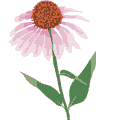Translate this page:
Summary
Sphagneticola trilobata,
Singapore Daisy is an ideal ground cover for warm climates, and it is known for its resilience and adaptability. It can withstand the extreme heat and sun of environments like the central Arizona desert, making it one of the few ground cover species suitable for such harsh conditions. Although it tolerates light pedestrian traffic, its brittle stems can break easily and should be kept away from heavy foot traffic. Medicinally, a strong decoction of the whole plant is used to treat severe chest colds and is combined with Lantana camara as a tea or syrup. The leaves are included in a cough and cold remedy, along with the boiled leaves of Commelina nudiflora or Hibiscus sabdariffa.
It is a long-lived perennial herb with a creeping, prostrate, or climbing habit. It often forms a dense mat that reaches 15-30 cm tall but can occasionally grow up to 70 cm. The plant’s stoloniferous growth allows it to crowd out other species, making it a vigorous ground cover that can dominate an area. It can also climb slightly up trees or other vegetation.
While the plant’s tops are killed by frost, its roots generally survive and regrow with warmer weather. It thrives in full sun to moderate shade, flowering more abundantly when exposed to sunlight. The plant grows well in various soil types, whether dry or moist and can handle drought and temporary inundation. Its salt resistance also makes it suitable for coastal areas.
Harvesting: summer for its foliage or flowers.
Physical Characteristics

 Sphagneticola trilobata is an evergreen Perennial growing to 0.4 m (1ft 4in) by 0.4 m (1ft 4in) at a fast rate.
Sphagneticola trilobata is an evergreen Perennial growing to 0.4 m (1ft 4in) by 0.4 m (1ft 4in) at a fast rate.
See above for USDA hardiness. It is hardy to UK zone 10. The flowers are pollinated by iInsects, especially bees and butterflies. The plant is not self-fertile.
It is noted for attracting wildlife.
Suitable for: light (sandy), medium (loamy) and heavy (clay) soils, prefers well-drained soil and can grow in nutritionally poor soil. Suitable pH: mildly acid, neutral and basic (mildly alkaline) soils. It can grow in semi-shade (light woodland) or no shade. It prefers dry or moist soil and can tolerate drought.
UK Hardiness Map
US Hardiness Map
Synonyms
Complaya trilobata (L.) Strother. Silphium trilobatum L. Thelechitonia trilobata (L.) H.Rob. & Cuatrec. Wedelia carnosa Rich. Wedelia paludosa DC. Wedelia trilobata (L.) Hitchc.
Plant Habitats
Edible Uses
References More on Edible Uses
Medicinal Uses
Plants For A Future can not take any responsibility for any adverse effects from the use of plants. Always seek advice from a professional before using a plant medicinally.
A strong decoction of the whole plant is used to treat severe chest colds[348 ]. It is combined with Lantana camara, as a tea or syrup, as a remedy for colds[348 ]. The leaves are included in a cough and cold remedy along with the boiled leaves of Commelina nudiflora or Hibiscus sabdariffa, and sometime also Citrus aurantiifolia[348 ]. The plant contains acetylenes and derivatives of kaurenic acid[348 ].
References More on Medicinal Uses
The Bookshop: Edible Plant Books
Our Latest books on Perennial Plants For Food Forests and Permaculture Gardens in paperback or digital formats.

Edible Tropical Plants
Food Forest Plants for Hotter Conditions: 250+ Plants For Tropical Food Forests & Permaculture Gardens.
More

Edible Temperate Plants
Plants for Your Food Forest: 500 Plants for Temperate Food Forests & Permaculture Gardens.
More

More Books
PFAF have eight books available in paperback and digital formats. Browse the shop for more information.
Shop Now
Other Uses
Agroforestry Uses: An interesting ground cover plant for warm locations. The stems are brittle and break easily, so should be kept away from foot traffic[423 ]. The plant can tolerate light pedestrian traffic[200 ]. Singapore Daisy is often used as a ground cover to prevent soil erosion and can be used in landscape designs for its attractive flowers. Other Uses: ornamental. It is one of the few ground cover plants that can survive central Arizona desert combination of extreme heat and sun at ground level. 1. Nectary - Flowers rich in nectar and pollen:
Yes – Singapore daisy produces yellow flowers that attract pollinators like bees and butterflies, providing nectar and pollen.
2. Wildlife - Food (Fruit, Seeds, Leaf litter, Shelter, Nesting, Roosting):
No – While the plant can provide some habitat, it is not a significant food source for wildlife. Its dense growth may offer limited shelter, but it is not typically used for nesting.
3. Invertebrate Shelter (Overwintering sites, Leaf litter, Groundcover):
Yes – The dense mat of Singapore daisy can provide some cover for invertebrates and serve as a groundcover that can retain moisture and support biodiversity.
4. Pest Confuser (Smell):
No – While it may not have strong pest-confusing properties, its dense growth can help suppress some weed species, indirectly aiding in pest management.
Special Uses
Ground Cover
References More on Other Uses
Cultivation details
A plant of the moist tropics, where it can be found at elevations up to 700 metres[413 ]. A long-lived perennial herb with a creeping prostrate scrambling or climbing habit. This mat-forming stoloniferous plant often creates a dense ground cover (usually 15-30 cm tall but occasionally up to 70 cm tall) that crowds out the growth of other species. It may also climb a short distance up trees or over other vegetation.Plant tops can be killed by frosts, but the roots will survive at least some frost and regrow with warmer weather[423 ]. Succeeds in full sun to moderate shade, flowering more heavily in a sunny position[413 , 423 ]. Succeeds in most soil types[413 ]. Prefers a well-drained soil, but is very tolerant, succeeding in dry and moist conditions, tolerating inundation and withstanding drought[413 , 423 ]. The plant is very salt-resistant, growing well near the sea[413 , 423 ]. Often cultivated as an ornamental, the plant readily escapes from gardens and forms a dense ground cover, crowding out or preventing regeneration of other species. In plantations, it will compete with crops for nutrients, light and water, and reduce crop yields[413 ]. Plant seldom sets fertile seed under local conditions. Propagation is mostly vegetatively as seeds are usually not fertile. Singapore Daisy is a fast-growing plant that can quickly establish and spread in favorable conditions, making it effective for ground cover.
References Carbon Farming Information and Carbon Sequestration Information
Temperature Converter
Type a value in the Celsius field to convert the value to Fahrenheit:
Fahrenheit:
The PFAF Bookshop
Plants For A Future have a number of books available in paperback and digital form. Book titles include Edible Plants, Edible Perennials, Edible Trees,Edible Shrubs, Woodland Gardening, and Temperate Food Forest Plants. Our new book is Food Forest Plants For Hotter Conditions (Tropical and Sub-Tropical).
Shop Now
Plant Propagation
Seed (poor), Division, Cuttings. Tip cuttings are very easy[423 ].
Other Names
If available other names are mentioned here
Bay Biscayne creeping oxeye, Bay Biscayne creeping-oxeye, creeping daisy, creeping ox eye, creeping ox-eye, creeping oxeye, creeping wedelia, rabbit's paw, Singapore daisy, trailing daisy, wedelia, yellow dots
Native Range
NORTHERN AMERICA: Mexico (Campeche, Chiapas, Quintana Roo, Tabasco, Veracruz de Ignacio de la Llave) SOUTHERN AMERICA: Belize, Costa Rica, Guatemala, Honduras, Nicaragua, Panama, French Guiana, Guyana, Suriname, Venezuela, Brazil, Colombia, Ecuador, Peru
Weed Potential
Right plant wrong place. We are currently updating this section.
Please note that a plant may be invasive in one area but may not in your area so it's worth checking.
The IUCN has listed S. trilobata in its 100 of the world's worst invasive alien species and the Florida Exotic Plant Pest Council classified it as a category II invader. This species continues to be available as an ornamental and is therefore likely to spread further.
Conservation Status
IUCN Red List of Threatened Plants Status :

Growth: S = slow M = medium F = fast. Soil: L = light (sandy) M = medium H = heavy (clay). pH: A = acid N = neutral B = basic (alkaline). Shade: F = full shade S = semi-shade N = no shade. Moisture: D = dry M = Moist We = wet Wa = water.
Now available:
Food Forest Plants for Mediterranean Conditions
350+ Perennial Plants For Mediterranean and Drier Food Forests and Permaculture Gardens.
[Paperback and eBook]
This is the third in Plants For A Future's series of plant guides for food forests tailored to
specific climate zones. Following volumes on temperate and tropical ecosystems, this book focuses
on species suited to Mediterranean conditions—regions with hot, dry summers and cool, wet winters,
often facing the added challenge of climate change.
Read More
Expert comment
Author
(L.) Pruski
Botanical References
Links / References
For a list of references used on this page please go here
A special thanks to Ken Fern for some of the information used on this page.
Readers comment
| Add a comment |
|
If you have important information about this plant that may help other users please add a comment or link below. Only comments or links that are felt to be directly relevant to a plant will be included. If you think a comment/link or information contained on this page is inaccurate or misleading we would welcome your feedback at [email protected]. If you have questions about a plant please use the Forum on this website as we do not have the resources to answer questions ourselves.
* Please note: the comments by website users are not necessarily those held by PFAF and may give misleading or inaccurate information.
To leave a comment please Register or login here All comments need to be approved so will not appear immediately.
|
Subject : Sphagneticola trilobata
|
|
|
|